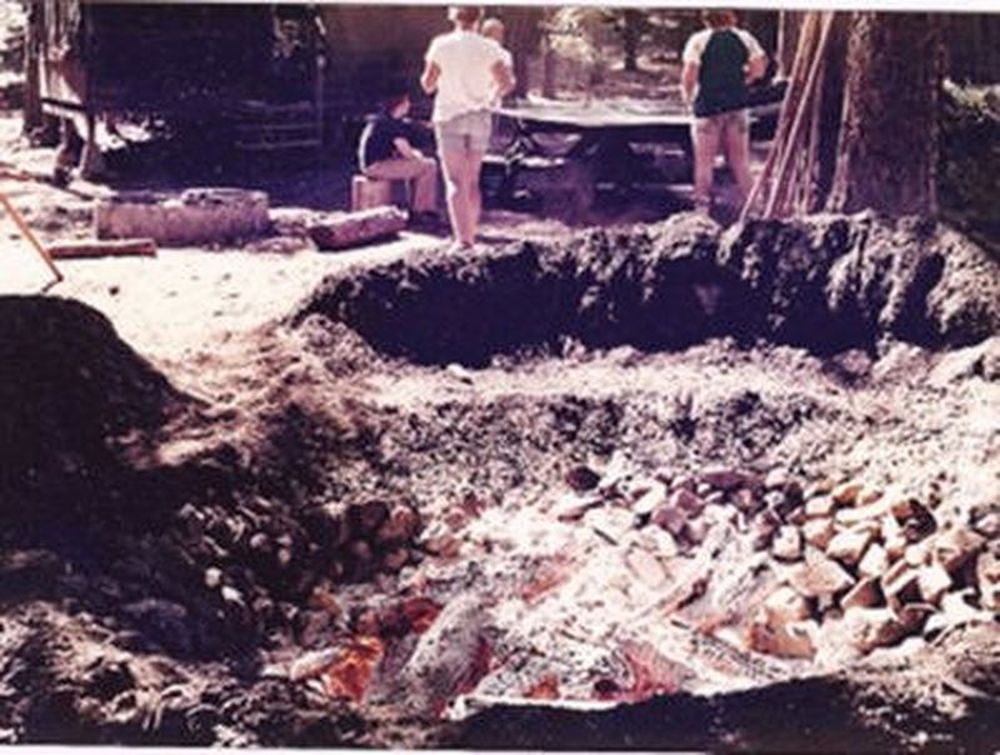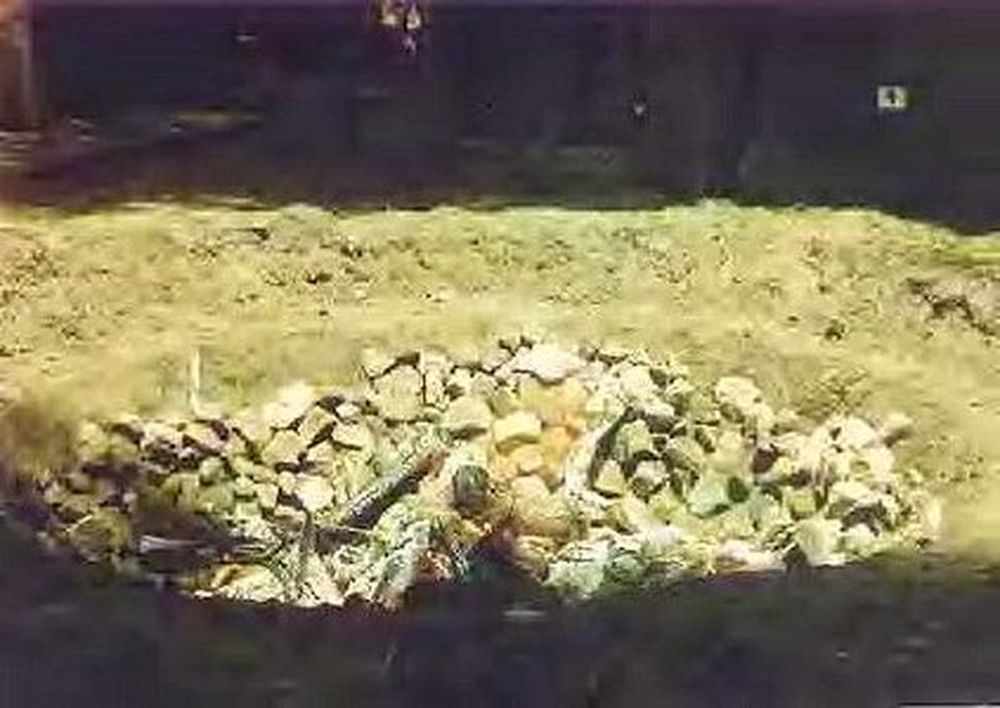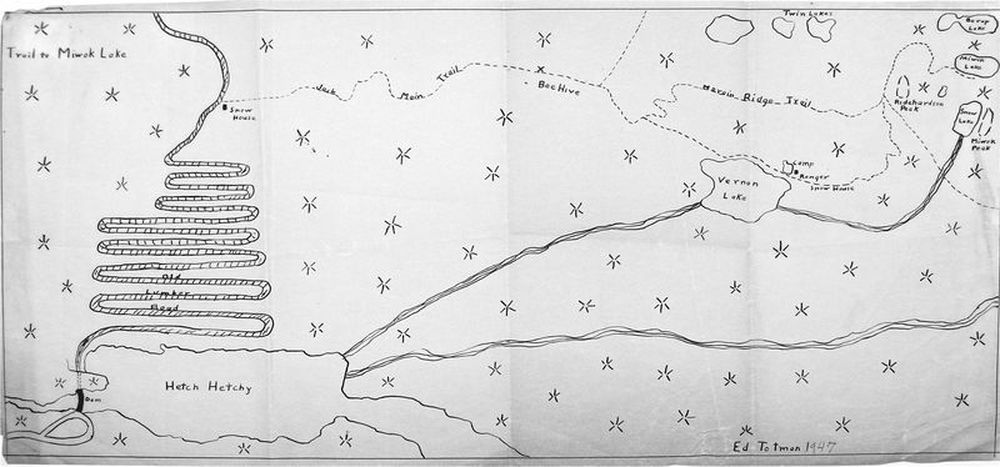Site Navigation: Home » Camp_MIWOK
Camp Name:
Name Pronunciation:
Name Origination:
Council Affiliation 1:
Council Affiliation 2:
Property:
Location:
Location Coordinates:
County:
First Year:
Final Year:
Years Active:
Disposition:
Acreage:
Elevation:
Address:
Phone:
Notes:
MIWOK
“mee wuk”
Named after the MIWOK Tribe
Oakland Area Council #21 (1916-1964)
San Francisco Bay Area Council #28 (1964-2020)
US Forest Service
Yosemite National Forest
38.056135, -119.701119 (click on coordinates for Camp Location)
Tuolumne
1940
1980
40
MIWOK ended two years after Dimond-O closed in 1978
n/a
8,166 Feet
Boy Scout Camp, Mather, CA
None
First week held at Camp Dimond-O and second week held at MIWOK Lake, MIWOK Lake was named by Scouts of Dimond-O
MIWOK was a two-week outdoor Junior Leadership Training (JLT) course developed by the Oakland Area Council in 1940 and then continued on by the San Francisco Bay Area Council until 1980. The purpose of MIWOK training was to prepare scouts and explorers for leadership positions within their units and was initially required for all scouts that wanted to work on camp staff at either Camp Dimond (1919-1948) or Dimond-O (1925-1978).
In March of 1940, the Oakland Area Council announced that a special training would be offered at its Dimond-O summer camp near Yosemite for junior camp leaders. Although the leadership training course began without a name, after much deliberation the name of MIWOK was selected in July 1940 as their camp group designation. The name was taken from the Tribe of Indians that inhabited the Yosemite area of California. During its first year the group was called the Miwok Tribe of Junior leaders and was composed of four patrols (Yosemite, Mono Mariposa and Tioga). The MIWOK group name was consistent with the names of the other camping groups at Dimond-O (Rangers, Vigilantes, Mountaineers, Frontiersman).
MIWOK training in later years would also be known as MIWOK JLT (Junior Leadership Training). The first week of MIWOK training was based out of Camp Dimond-O near Yosemite and then the second week was held at MIWOK lake, about 10 miles north of Hetch Hetchy Reservoir.
In the summer of 1941 the MIWOK Tribe turned into MIWOK training. Under the leadership of Its first Scoutmaster Harold Farquar, the MIWOKS were arranged into a troop where they lived for two weeks as a camping unit. The first group of MIWOKs consisted of a group of 18 Junior leaders who would serve at Dimond-O during the following session of the Mountain Camp. The group set up their camp in the area between the first-aid station and the Dimond-T camping area. Indian ceremonies formed an important part of the camp life, equal to the traditions of the other camp groups such as the totem poles of the Mountaineers and the burial ceremony of the Vigilantes.
Those completing the first MIWOK training course were: Don Ayers (Troop 100), John Beale (Troop 54), Roland Bendel (Sea Scout Ship 108, Niles), Paul Biermann (Troop 41), Arnold Bjornsen (Troop 89), John Brown (Troop 84), Scott Chalfant (Troop 54), Dean Christensen (Sea Scout Ship Flying Cloud), Filson Durand (Troop 66), Bruce Fisher (Troop 50), Bill Flagler (Troop 64), Fred Gaine (Troop 9), Joe Hebrew (Troop 89), Wesley Housman (Troop 91), Howard Martin (Troop 89), Perry Olson (Troop 54), Don Robertson (Troop 18), Tom Scott (Troop 58), Bob Smyth (Troop 94), and Bill Thompson (Troop 3).
The first week of MIWOK was held within the camping area at Dimond-O and consisted of discussion groups, learning scoutcraft and sessions with the camp leadership and administration specialists. Through the learning-by-doing method, scouts and explorers work toward a common objective, to be able to serve as effective junior leaders. The second week of the training consisted of a five-day trek planned in the High Sierra back country near Hetch Hetchy reservoir as a final test of their skills in hiking, planning and camping. The destination of the trek was MIWOK Lake which had been used by the MIWOK scouts since 1940. The course was open to as many as 40 scouts but in the later years there were as many as 57 scouts participating in the training. According to former MIWOK scoutmaster Durland Skinner, this caused a few raised eyebrows from Park Rangers regarding the impact to the sierras as the large group came walking back from MIWOK.
MIWOK Lake:
MIWOK Lake is located about 12 miles North-East of the Hetch Hetchy dam at an elevation of 8166 feet in the Yosemite National Forest and was discovered by the first MIWOK Troop in July 1940 while searching for a place to camp. At the time the lake was not indicated on any USGS topographical maps, so the Scouts named it MIWOK Lake after the course name (naturally). When the lake and its name was reported to the National Park Service, the NPS verified it as being an unnamed lake. The lake was eventually surveyed in the late 1940’s and was officially named MIWOK Lake and added to all future USGS topo maps because of the scouts. MIWOK Lake is and always will be a Scout lake named by campers from Dimond-O of the Oakland Area Council.
MIWOK Scoutmaster:
Hal Faquar- First Miwok Scoutmaster – 1940, 1941
Jack MacGregor – 1942
Elgin Orcutt – 1945
Jack Irwin – 1946
Dr. Robert Adams – 1953, 1954
Del Anderson – 1958
Durand Skinner – 1957 to 1971, 1975
Joe Remlinger – 1963 to 1971, 1975
Ed Menaenskl – 1977, 1978
The Hike to MIWOK (John Packer – Miwok 1977):
Miwok Lake is approximately 13 miles from Hetch Hetchy Dam and it normally took about two days of hiking to reach the lake. However, to reach Miwok Lake required a 4300 foot elevation climb starting at the dam (3800 feet) up to Miwok Lake (8166 feet).
The first night would be spent at a meadow above the dam so we needed to get up before the light of day to start hiking the numerous switch backs to avoid the afternoon heat. In the early years the Scouts used pack animals on the trail too. Because of Forest Service guidelines regarding the size of groups on the trail, we didn’t wear our Scout uniforms so we couldn’t be identified as one single group.
The first night was spent at a meadow called Beehive. It’s a large meadow with lots of mosquitos and a natural spring nick named the “Coke Machine”. At Dimond-O before we set out for the lake, the staff would tell the scouts about the “Coke” machine at Beehive and change out three quarters for their dollars because the Coke machine only took quarters. As a side note, a number of MIWOK’s must have also worked on staff at Wente Scout Reservation. That same “Coke Machine” scenario was also located in the back hills of Wente. I can remember as a young first year scout at Wente being told about the Coke machine on our overnight hike. The leaders were using it as an incentive to keep us moving by getting a soda at the ranch. Once we made it to the ranch, it turned out to be a broken down house with no Coke machine, the trick worked.
In 1977 we got hit by bears at Beehive so bad that we completed the hike in one day. Because of the size of the MIWOK group, two patrols would stay at Ardeth Lake and two patrols would stay at MIWOK lake. The week was mix of fun, work and ceremonies. We had to finish work on our notes from the competencies because we had to present our “Ticket” when we returned to camp. We climbed Mahan Peak where there was a MIWOK time-capsule, and we would read the notes from past Scouts and leave one of our own. There is a MIWOK time-capsule at Beehive meadow as well. During some years, depending on the snow melt, we would also climb Richardson Peak. In addition to the nightly campfires, permanent patrol leaders were voted on by the Scouts and identified at one of the campfire ceremonies. This was an honor because we were nearing the end of the training and your peers selected you.
During our stay at Miwok Lake, we also hunted for the “MIWOK chicken”, an elusive creature that was never seen but at times a scout would find a hen’s nest and a single egg she had laid. The egg had to be brought back to camp intact. The egg of course had been packed-in by Staff and placed in the brush to be found.
We typically were in the back country for five days. On our way back to Dimond-O, we made the hike out in one day and always stopped at the Evergreen Lodge before returning to camp. The waitresses there were expecting us, and it became a tradition to pile in and eat as much greasy food and ice cream as we could stomach. Once back at Dimond-O it was time to get cleaned up and hand in our MIWOK ticket, showing that we had mastered all the training during the previous two weeks.
The last session of MIWOK based out of Dimond-O took place during the summer of 1978 as Dimond-O would close forever. MIWOK would continue for another two years but the final MIWOK sessions were held at the Camp Cedarbrook of the Alameda Council. Cedarbrook was located in the town of Long Barn on highway 88 about 10 miles from Pinecrest Lake. Camp Cedarbrook itself would close in 1999.
MIWOK Songs:
No, I can’t go out and play.
I have to work all day.
If I was half their size
I’d tell those guys
To go jump in the Bay!
Ain’t got no wampum
So guess me sit and talk.
Ain’t got no roller skates
So guess me walk!
M, I, W-O-K!
M, I, W-O-K!
M, I, W-O-K!
Miwok!
After the completion of MIWOK, the staff would cook a closing meal on Saturday night for the candidates and their guests. The feast was known as the MIWOK Emu and was an underground pit cooking method used by the MIWOK staff. The pit was dug on Friday at Dimond-O and a large fire was created in the pit to create a bed of hot coals. The Emu Pit recipe called for 70 pounds of beef loin (boneless and trimmed), 50 pounds of potatoes, 25 pounds of carrots, 25 pounds of onions and lots of salt and pepper. Everything was wrapped in foil and placed on the bed of coals. The pit was then covered up and left to cook underground or 24 hours. On Saturday afternoon the pit was opened up and the fully cooked meal was removed for the Saturday evening dinner and the MIWOK closing.



STEM
Order of the Arrow